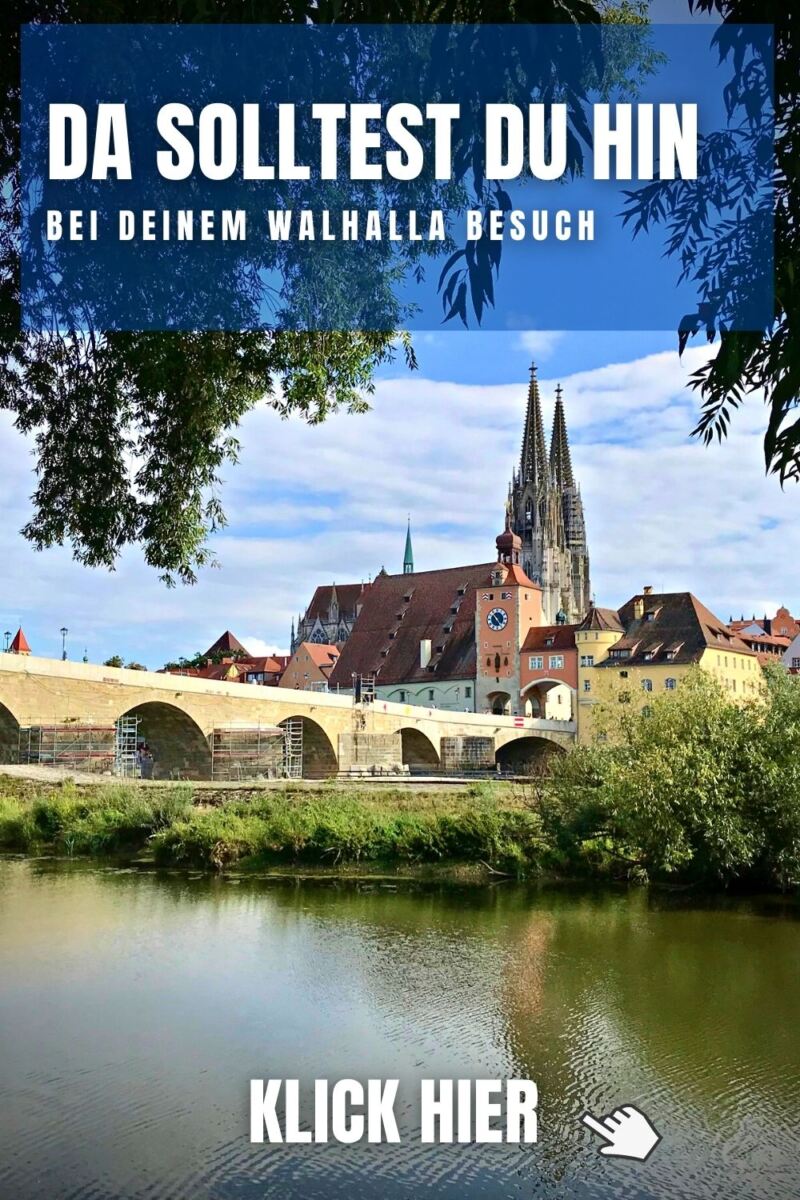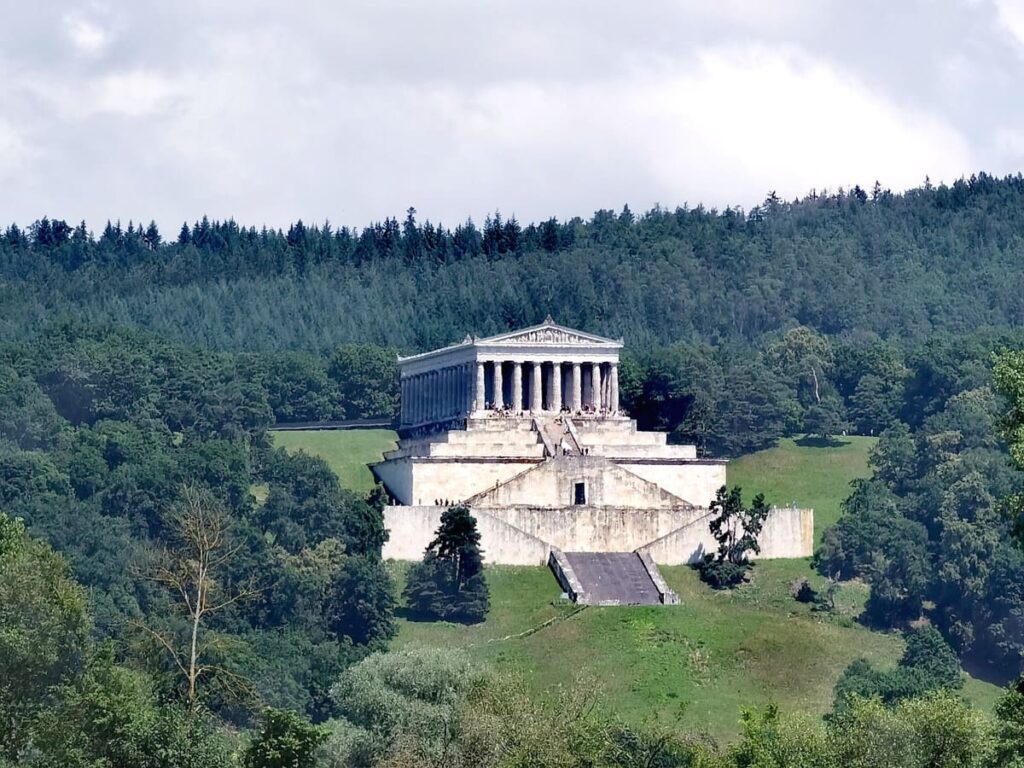
Darum geht es hier:
Valhalla Ratisbon – the Bavarian Acropolis
The Valhalla Ratisbon is one of the most striking buildings that Bavaria has to offer. It is reminiscent of a temple. She has no religious background at all. It is a memorial, a particularly impressive memorial. The magnificent building towers above the small town of Donaustauf with a view of the Danube. The pillars are mighty. My little son speaks of the Bavarian Acropolis. And he’s right: The Valhalla is very similar to the Parthenon Temple on the Acropolis. However, the Acropolis is far less well preserved than the Valhalla. We have also been to Athens with children and we looked at the city and the temple. The similarity of the two buildings is not accidental: the magnificent Greek building in Athens was the model for the Bavarian palace. Carl Haller von Hallerstein was entrusted with planning the memorial. In his search for the perfect building, he looked to the Acropolis in Athens. Thanks to a grant from the Bavarian king, he traveled to Athens and got the architectural ideas from Greece. This is the reason for the similarity to the well-known Greek temple. Today the Valhalla towers imposingly over the surroundings, just as the temple on the Acropolis shines over Athens.
But unlike Greece, where the Acropolis is in the middle of the city, the Bavarian Acropolis is in the countryside. By the way, that wasn’t originally planned! King Ludwig I actually wanted the magnificent building to be built in Munich . The building was supposed to be in the English Garden. In the search for the perfect place for the magnificent temple, there was a change of plan. Together with the architect Klenze, the king found the location in the Danube valley. The Bräuberg near Donaustauf seemed ideal to them. This is how things were planned and built near Regensburg: Today, the huge structure towers mightily and sublimely over the landscape in Bavaria.
When was Valhalla built?
On October 18, 1830, the foundation stone was laid on the Bräuberg in Donaustauf. The date of the laying of the foundation stone was specially selected: it is the 17th anniversary of the Battle of the Nations near Leipzig . This event is connected with the shameful defeat of the German people. With the construction of the Valhalla Ratisbon, a sign for Germany and its inhabitants should be set – as well as with the Monument to the Battle of the Nations in Leipzig. The Valhalla took twelve years to build. The completion of the huge stone monument was in 1842. Incidentally, the white stone comes from the Altmühltal, near Kelheim. In this respect, the Valhalla has a connection to Kelheim – even if it is not built there, as many people wrongly believe. Kelheim is home to another well-known attraction, the Danube Gorge. But back to the Hall of Fame: the opening ceremony was again scheduled for October 18th. King Ludwig I opened the Walhalla on October 18, 1842 with these words:
„May Walhalla be conducive to the strengthening and multiplication of German senses! May all Germans, whatever their tribe, always feel that they have a common fatherland, a fatherland of which they can be proud, and everyone should contribute as much as they can to its glorification.”
King Ludwig I, at the opening
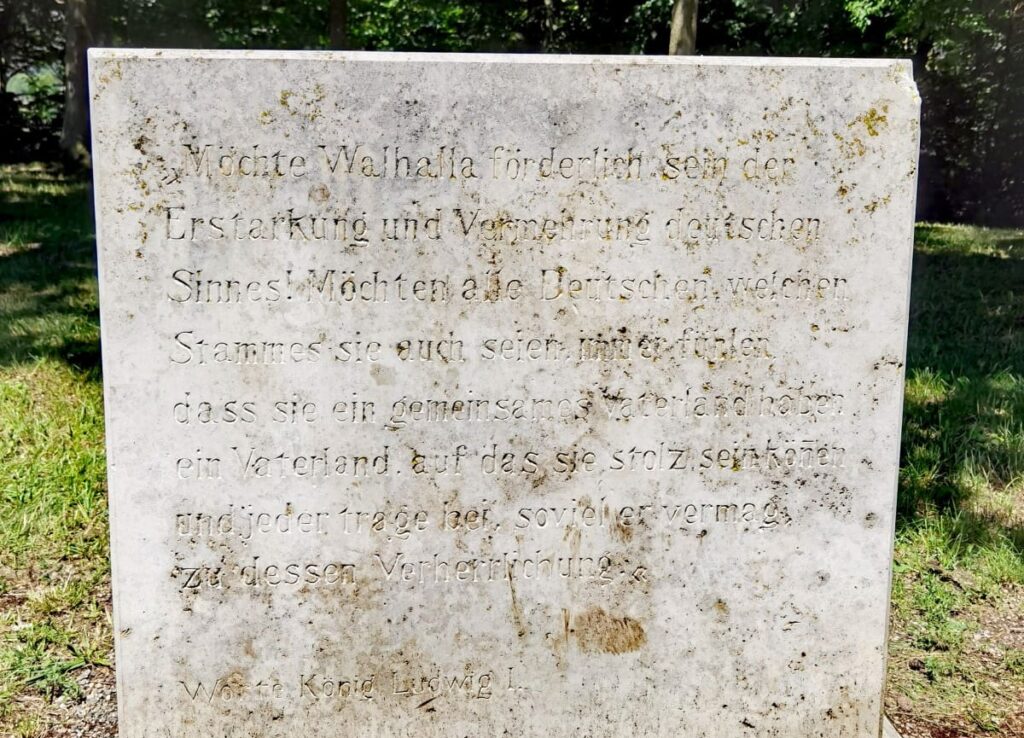
Why was the Valhalla Ratisbon built?
The construction of the Temple of Fame was politically desired. After the defeat against Napoleon and the dissolution of the Holy Roman Empire, a monument was to be built to create self-confidence in the Germans. It had to be powerful , sublime and something special. The German Hall of Fame has been planned since 1810. Today you can see the result at your visit to the Walhalla.
–> what to see inside the Valhalla
What is the Valhalla Ratisbon?
Today the Walhalla is one of the most visited sights in Bavaria . At the same time, it is one of the top 100 sights in Germany. The magnificent temple with no religious background attracts hundreds of thousands of visitors every year. It’s a great trip from Regensburg to the Walhalla. You can climb up the giant stone steps from the Danube or just take the short walk from the parking lot to the Temple of Fame. I love walking between the huge stone pillars with the view over the Danube. Those interested in culture visit the interior of the building. You have to pay for the entrance in the monument. The whole sourrouding can be reached free of charge. If you like hiking, you can go hiking. Below I give you my hinte which Valhalla hike is particularly beautiful. Before that, information about admission and opening times:
–> Valhalla admission
–> Valhalla opening times
This is what you should know about the Valhalla Ratisbon
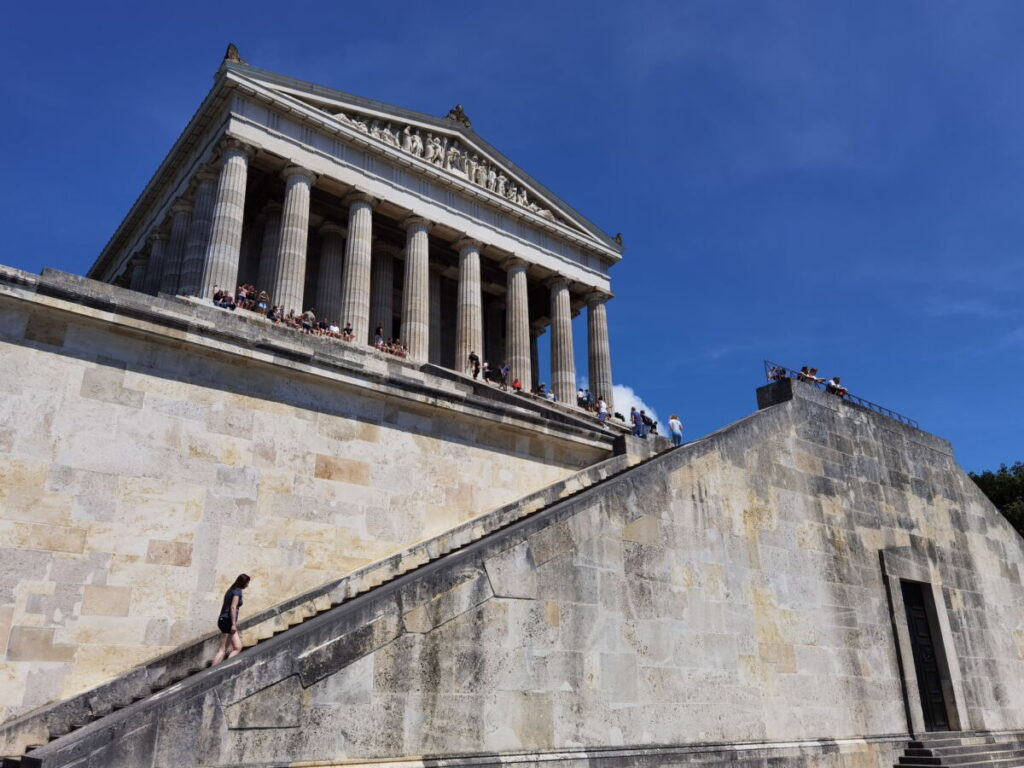
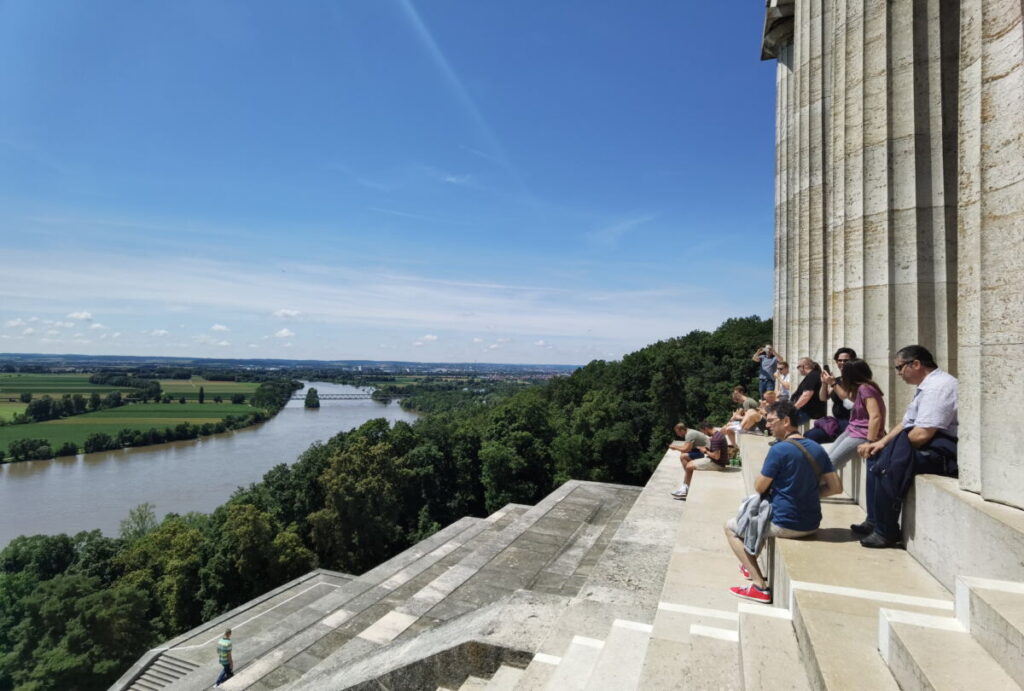
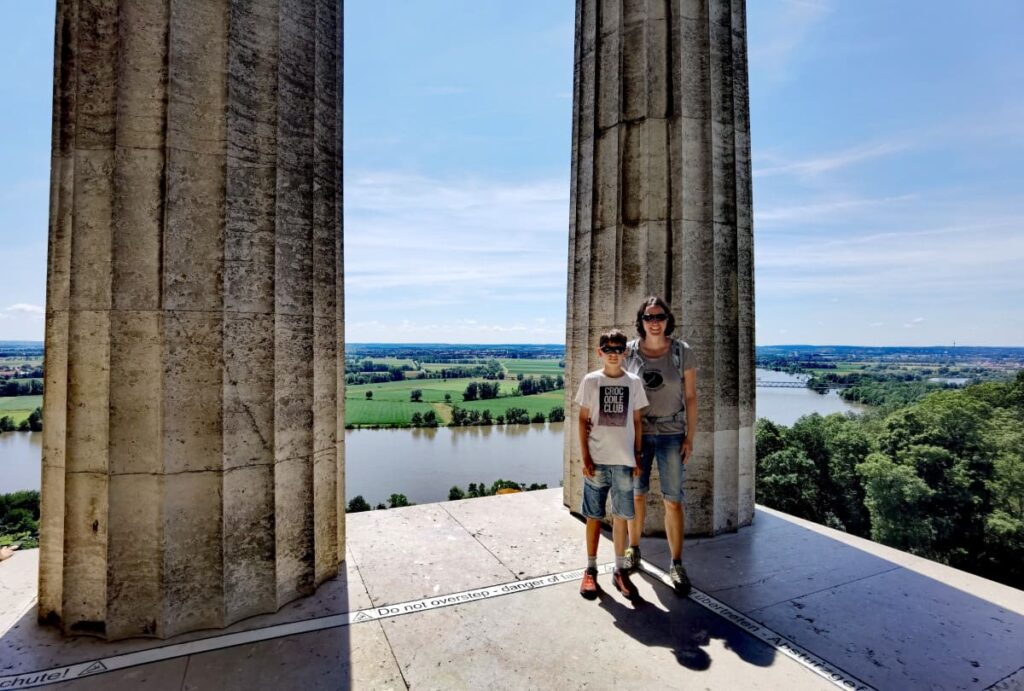
In the interior of the Walhalla, 130 busts of well-deserving personalities with a „German tongue“ are on display. There are also 64 commemorative plaques for people who have achieved something extraordinary, but whose portrait has not survived. This includes, for example, the poet of the Nibelungenlied, the builder of the Cologne Cathedral or the inventor of the pocket watch.
By the way: The spiritual builder of the Walhalla, King Ludwig I, was included in the select group of busts after his death. You can find his bust inside. New busts are constantly being added. The Bavarian Council of Ministers appoints them on the recommendation of the Bavarian Academy of Sciences. You can suggest anyone. If your proposal is accepted, the full costs of more than 30,000 euros must be borne.
Speaking of money: The construction of the Walhalla cost the equivalent of more than 80 million euros. What else do you get for 80 million euros? – That’s how much the construction of the Elbphilharmonie in Hamburg was originally supposed to cost, which ultimately cost 800 million euros
What does Valhalla mean?
Where does the name come from and what does it mean? The Valhalla Hall of Fame takes its name from Walhall or Old Norse Valhöll , Valhall or Valhalla. That means something like dwelling of the fallen .
Facts and figures
| Built: | 1830-1842 |
| Building-costs: | 80 million euros |
| Height of the temple: | 20 metres |
| Length of the temple: | 66.7 meters |
| width of the temple: | 31.6 meters |
All information for your trip and visit
It is one of the top sights in Germany. If you are in the area, you should definitely go there. Thanks to the fast connection to the highway, this works quite well. The Valhalla is even perfect for a short stop while passing through. You can drive almost directly to the building by car. We find the approach from the Danube more stylish and impressive. I described here how we walked up from the Danube to the Hall of Fame. For those who want to drive straight up, we also have the description of how to get to the Walhalla by car. Many use Regensburg as a starting point for the excursion. You will also find the necessary information for this, where you can park perfectly at the Walhalla Regensburg, or which bus leaves Regensburg:
-> Walhalla – how to get there
-> Walhalla parking lot
This is how you get to the destination
No matter how you get here, the last piece is always to be walked. In my opinion, the impressive ascent over the southern flank is worthwhile . On this short hike to the Walhalla, the building has a special effect. Technically, this hike is not difficult, but you have to climb a few steps. You approach from the Danube step by step. If you want to hike further, you should check out the longer circular hike. I really liked it there, especially the perspective over the Danube. How you find this special ascent and which other hikes are worthwhile, I describe in this article:
-> Walhalla hike
Good Links
- enjoy also these Regensburg Sehenswürdigkeiten
- we love these Natursehenswürdigkeiten in Bayern
- have a look to these Deutschland Sehenswürdigkeiten
FAQ about Valhalla
Valhalla, also known as Valhalla Ratisbon, is a striking and monumental building located in the vicinity of Donaustauf, Bavaria, Germany. It stands as an awe-inspiring memorial, resembling a temple in its architectural grandeur. While it does not have any religious affiliations, it holds profound historical and cultural significance for the Bavarian region. Often referred to as the „Bavarian Acropolis,“ Valhalla commands a commanding presence over the quaint town of Donaustauf, offering panoramic views of the meandering Danube River. Its colossal pillars evoke parallels with the renowned Parthenon Temple atop the Athenian Acropolis, albeit in a notably better state of preservation. This resemblance is by design, as the architect, Carl Haller von Hallerstein, drew architectural inspiration from the ancient Greek masterpiece during his sojourn in Athens, facilitated by a grant from the Bavarian king.
The foundation stone for Valhalla was ceremoniously laid on the historic date of October 18, 1830, a deliberate choice that commemorated the 17th anniversary of the Battle of the Nations near Leipzig. This pivotal event in German history marked a somber moment of defeat, and with the construction of Valhalla, it sought to serve as a symbol of collective German identity and pride. The ambitious undertaking spanned over a dozen years, culminating in the completion of this colossal stone edifice in 1842. The pristine white stone used in its construction was sourced from the Altmühltal, in close proximity to Kelheim, forging a geographical connection to the region.
Valhalla’s conception was politically motivated, emerging in the aftermath of the defeat against Napoleon and the dissolution of the Holy Roman Empire. It was envisaged as a monumental testament to rejuvenate the spirit and self-assurance of the German people. This structure was envisioned to be not only powerful and sublime but also distinctive, serving as a beacon of resilience and unity in the face of historical adversity. The concept for the German Hall of Fame had been germinating since 1810, with Valhalla ultimately realized as a resounding statement of German heritage and achievement.
Upon venturing into the hallowed halls of Valhalla, visitors are greeted with a stunning display of 130 meticulously crafted busts, each representing a distinguished individual with a German lineage. These busts immortalize figures who have made indelible contributions to German culture, history, and society. Additionally, there are 64 commemorative plaques, paying tribute to extraordinary individuals whose portraits have not been preserved through time. Among this esteemed assembly are luminaries such as the poet of the Nibelungenlied, the visionary behind the Cologne Cathedral, and the inventor of the pocket watch, each granted a place of honor within Valhalla’s sacred precincts.
There are some more magic monuments you should visit:
Schiefer Turm von Pisa (Leaning Tower of Pisa)
The Schiefer Turm von Pisa, or Leaning Tower of Pisa, is an iconic bell tower located in the Italian city of Pisa. Its distinctive lean is the result of unstable soil conditions during its construction in the 12th century. Despite its unintended tilt, the tower stands as a testament to medieval architecture and engineering. Visitors can climb the tower for panoramic views of Pisa.
Website: Schiefer Turm von Pisa
Ponte Vecchio
The Ponte Vecchio is a historic bridge spanning the Arno River in Florence, Italy. It is renowned for its unique architecture and for being lined with shops, primarily jewelers and art dealers. The bridge offers stunning views of the river and is an iconic symbol of Florence’s rich cultural heritage.
Website: Ponte Vecchio
Pragser Wildsee (Lake Braies)
Pragser Wildsee is a picturesque alpine lake nestled in the Dolomites of South Tyrol, Italy. Surrounded by lush forests and towering peaks, it boasts crystalline waters that mirror the breathtaking scenery. Visitors can partake in activities like boating, hiking, and photography, making it a haven for nature enthusiasts.
Website: Pragser Wildsee
Lago di Tenno
Lago di Tenno is a tranquil mountain lake situated near the town of Tenno in northern Italy. This emerald-green lake is known for its serene atmosphere and clear waters. The surrounding medieval village of Canale adds to the charm, with its well-preserved architecture and narrow cobblestone streets.
Website: Lago di Tenno
Prebischtor
The Prebischtor, or Pravčická brána, is a natural sandstone arch located in Bohemian Switzerland, Czech Republic. It is the largest natural sandstone gate in Europe and is nestled amidst a scenic landscape of towering rock formations and lush forests. Hiking trails in the area lead to this awe-inspiring natural wonder.
Website: Prebischtor
Tyssaer Wände (Tisá Walls)
The Tyssaer Wände, or Tisá Walls, are a series of dramatic sandstone cliffs and rock formations located in the Elbe Sandstone Mountains of Czech Republic. This natural wonderland is a haven for rock climbers, hikers, and nature enthusiasts. Its towering spires and labyrinthine canyons create a surreal and enchanting landscape.
Website: Tyssaer Wände
Reschensee
The Reschensee is a famous sight in Europe located in the Italian Alps. What makes Reschensee notable is the submerged bell tower of the 14th-century church of Graun. The tower is the only visible remnant of the village of Graun, which was submerged when the lake was created in 1950.
Website: Reschensee
Bad Gastein Wasserfall
The Bad Gasteiner Wasserfall is one of the biggest waterfalls in Europe. It is a beautiful natural attraction located in the town of Bad Gastein in the Austrian Alps. This waterfall is a notable feature in the region, known for its picturesque setting and accessibility. The waterfall is surrounded by the scenic landscapes of the Gastein Valley.
Website: Bad Gastein Wasserfall

